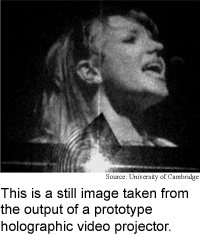
Holograms enable pocket projectors
By
Eric Smalley,
Technology Research NewsVideo projectors can make entire walls into television or computer screens. But video projection equipment is relatively bulky, which has confined video projection to lecture halls, conference rooms and home theaters.
Researchers from the University of Cambridge in England and Light Blue Optics Ltd. have found a way to leverage holographic technology to produce a small, laser-driven video projector.
The method could lead to pocket-sized, battery-powered video projectors that produce images whose quality matches that of today's full-sized projectors, according to Adrian Cable, a researcher at the University of Cambridge in England and director of Light Blue Optics Ltd. This type of projector could also be built into a laptop computer, said Cable.
Key to the device's diminutive size is the lack of lenses and high-power light bulbs. Conventional digital video projectors form images by generating a small picture on a transparent microdisplay inside the projector, then shining a high-power light through the microdisplay to a large magnifying lens.
In the researchers' design, a two-dimensional hologram is shown on the microdisplay rather than an image, and the projected image is formed by shining a laser beam through the microdisplay, which scatters the light into a particular pattern. "No lenses are required -- the projected image is formed entirely by diffraction," said Cable.
The challenge was producing a high-resolution hologram that can be changed quickly enough to project video images. "The relationship between images and the corresponding holograms is mathematically complex," said Cable.
The holographic projection of computer-generated images was first demonstrated in the 1970s, but has not been practical because the algorithms that generate the holograms have been too slow to use in real-time, said Cable. Faster algorithms exist, but they can only produce the simple light patterns used for optical communications, he said.
The researchers' algorithm solves the problem, said Cable. The key was studying how noise, or the distortion of an image, affects people's perception of video. The researchers showed test subjects 300 pairs of video images and asked them to rate which, if either, was higher quality. The images were the same but contained different levels of noise. The researchers found that variation in noise levels affected people's perception of video quality more than the actual level of the noise.
Most conventional two-dimensional hologram algorithms are designed to minimize noise levels, according to Cable. The researchers' one-step phase retrieval algorithm, in contrast, is designed to minimize noise variance.
The researchers' algorithm generates holograms about one million times faster than the standard direct binary search algorithm running on a 2 gigahertz Athlon personal computer, according to Cable.
The researchers' prototype is black and white. They are working on configuring two or more of the devices in parallel to generate full-color video.
The researchers aim to produce practical pocket-sized video projectors in two to five years, said Cable.
Cable's research colleagues were Edward Buckley, T. Wilkinson, Peter Mash, and N. Lawrence. The researchers presented the work at the Society for Information Display (SID) International Symposium 2004 in Seattle, Washington, May 23 to 28.
Timeline: 2-5 years
Funding: Unknown
TRN Categories: Displays; Optical Computing, Optoelectronics and Photonics; Data Structures and Algorithms
Story Type: News
Related Elements: Technical paper, "Real-Time Binary Hologram Generation for High-quality Video Projection Applications," Society for Information Display (SID) International Symposium 2004 May 23-28, Seattle, Washington
Advertisements:
June 30/July 7, 2004
Page One
Software fuse shorts bugs
Holograms enable pocket projectors
Memory cards make connections
Interface blends screen and video
Briefs:
Paper promises better e-paper
Birds-eye view helps guide public
Nanotubes boost neuron growth
Chip protects single atoms
Mega video enables virtual window
Method tests molecular devices

News:
Research News Roundup
Research Watch blog
Features:
View from the High Ground Q&A
How It Works
RSS Feeds:
News
Ad links:
Buy an ad link
| Advertisements:
|
 |
Ad links: Clear History
Buy an ad link
|
TRN
Newswire and Headline Feeds for Web sites
|
© Copyright Technology Research News, LLC 2000-2006. All rights reserved.